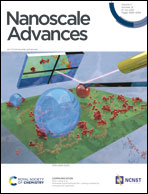Hydrothermally activated TiO2 nanoparticles with a C-dot/g-C3N4 heterostructure for photocatalytic enhancement†
Abstract
Dye degradation via photocatalysis technology has been investigated intensively to tackle environmental issues and energy crisis concerns. In this study, a newly designed ternary photocatalyst was facilely prepared by a simple one-pot hydrothermal process by directly mixing TiO2 nanoparticles with carbon dots (C-dots) and graphitic carbon nitride (g-C3N4). The optimized precursor treatments and heterostructure components show significantly enhanced photodegradation activity towards organic dyes Rhodamine B (RhB) and methylene blue (MB). Excellent photocatalytic activities were achieved owing to the better attachment of anatase-type TiO2 nanoparticle-aggregations to the C-dots/g-C3N4 (CC) nanocomposite, which impressively displays superhydrophilicity by employing the hydrothermal activation process. FT-IR spectra revealed that the hydrothermal treatment could remarkably increase the coupling interactions between TiO2 nanoparticles and the CC nanosheets within the ternary catalyst, enhancing the photocatalytic activity. Thus, it was concluded that this ternary photocatalyst is highly suitable for the remediation of dye-contaminated wastewater.



 Please wait while we load your content...
Please wait while we load your content...